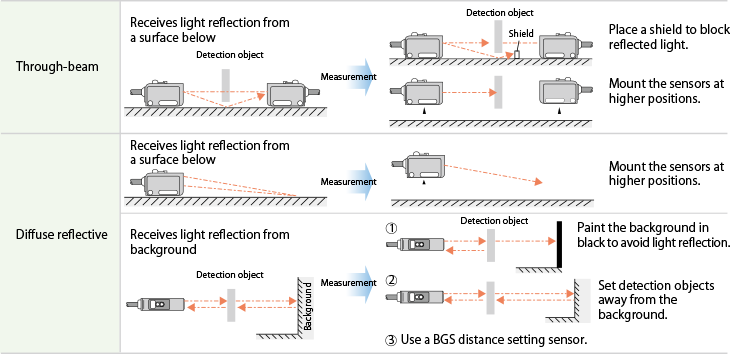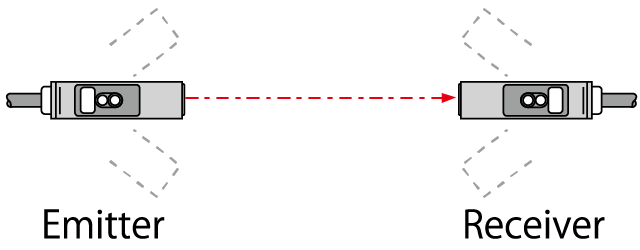Technical Guide for Photoelectric Sensors
1. Cross talk
-
When photoelectric sensors are installed next each other, operation of a sensor may become unstable affected from light from another sensor.
In this situation, avoid interference with the measurements listed below.
- Use connection models of fiber sensors.
- Separate the sensors not to get interfered, referring to a interference characteristic chart.
- Add a slit or polarizing filter on through-beam sensor.
- Install emitters and receivers of through-beam sensors or retro reflective sensors and reflectors in opposite orders.
* Pay attention that reflected light from an object of sensor does not enter to a receiver of next sensor. -

page top 
2. Influence from ambient illuminance
-
Although photoelectric sensors are designed to use modulated light to avoid influence from ambient illuminance, entrance of light from a high frequency fluorescent lamp or sunlight to the front of a sensor may cause mis operation of the sensor.
Examples of illuminance
Clear-sky sunlight・・・・・・・・・・・・ 100,000lx Cloudy-sky sunlight・・・・・・・・・・・・ 30,000lx Factory and office lighting・・・・・・・ 400~1,500lx
page top 
3. Installation

page top 
4. Light axis alignment
-

-
1) Mount an emitter and receiver on a line facing each other.
2) Move the emitter horizontally to confirm on angles, where the receiver receives light, then place the emitter at the center of angles.
3) Move the receiver horizontally to confirm on angles, where the receiver receives light, then place the receiver at the center of angles.
4) Repeat the same procedures in vertical directions.
page top 
5. General cautions
-
- When using a switching power supply, make sure to connect its frame ground terminal to the ground.
- Upon power on, do not use a sensor during its warm-up time, for 100ms~2s depending on a sensor model.
- Do not place a sensor cable in parallel to or in a same cable guide with a high-voltage or power line.
Such installation may result in malfunction of the sensor caused by induction.
page top 



